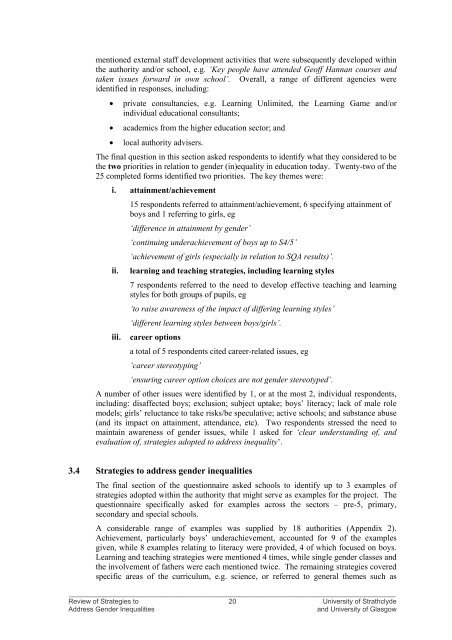Review of Strategies to Address Gender Inequalities in Scottish ...
Review of Strategies to Address Gender Inequalities in Scottish ...
Review of Strategies to Address Gender Inequalities in Scottish ...
You also want an ePaper? Increase the reach of your titles
YUMPU automatically turns print PDFs into web optimized ePapers that Google loves.
mentioned external staff development activities that were subsequently developed with<strong>in</strong>the authority and/or school, e.g. ‘Key people have attended Ge<strong>of</strong>f Hannan courses andtaken issues forward <strong>in</strong> own school’. Overall, a range <strong>of</strong> different agencies wereidentified <strong>in</strong> responses, <strong>in</strong>clud<strong>in</strong>g:• private consultancies, e.g. Learn<strong>in</strong>g Unlimited, the Learn<strong>in</strong>g Game and/or<strong>in</strong>dividual educational consultants;• academics from the higher education sec<strong>to</strong>r; and• local authority advisers.The f<strong>in</strong>al question <strong>in</strong> this section asked respondents <strong>to</strong> identify what they considered <strong>to</strong> bethe two priorities <strong>in</strong> relation <strong>to</strong> gender (<strong>in</strong>)equality <strong>in</strong> education <strong>to</strong>day. Twenty-two <strong>of</strong> the25 completed forms identified two priorities. The key themes were:i. atta<strong>in</strong>ment/achievement15 respondents referred <strong>to</strong> atta<strong>in</strong>ment/achievement, 6 specify<strong>in</strong>g atta<strong>in</strong>ment <strong>of</strong>boys and 1 referr<strong>in</strong>g <strong>to</strong> girls, eg‘difference <strong>in</strong> atta<strong>in</strong>ment by gender’‘cont<strong>in</strong>u<strong>in</strong>g underachievement <strong>of</strong> boys up <strong>to</strong> S4/5’‘achievement <strong>of</strong> girls (especially <strong>in</strong> relation <strong>to</strong> SQA results)’.ii. learn<strong>in</strong>g and teach<strong>in</strong>g strategies, <strong>in</strong>clud<strong>in</strong>g learn<strong>in</strong>g styles7 respondents referred <strong>to</strong> the need <strong>to</strong> develop effective teach<strong>in</strong>g and learn<strong>in</strong>gstyles for both groups <strong>of</strong> pupils, eg‘<strong>to</strong> raise awareness <strong>of</strong> the impact <strong>of</strong> differ<strong>in</strong>g learn<strong>in</strong>g styles’‘different learn<strong>in</strong>g styles between boys/girls’.iii. career optionsa <strong>to</strong>tal <strong>of</strong> 5 respondents cited career-related issues, eg‘career stereotyp<strong>in</strong>g’‘ensur<strong>in</strong>g career option choices are not gender stereotyped’.A number <strong>of</strong> other issues were identified by 1, or at the most 2, <strong>in</strong>dividual respondents,<strong>in</strong>clud<strong>in</strong>g: disaffected boys; exclusion; subject uptake; boys’ literacy; lack <strong>of</strong> male rolemodels; girls’ reluctance <strong>to</strong> take risks/be speculative; active schools; and substance abuse(and its impact on atta<strong>in</strong>ment, attendance, etc). Two respondents stressed the need <strong>to</strong>ma<strong>in</strong>ta<strong>in</strong> awareness <strong>of</strong> gender issues, while 1 asked for ‘clear understand<strong>in</strong>g <strong>of</strong>, andevaluation <strong>of</strong>, strategies adopted <strong>to</strong> address <strong>in</strong>equality’.3.4 <strong>Strategies</strong> <strong>to</strong> address gender <strong>in</strong>equalitiesThe f<strong>in</strong>al section <strong>of</strong> the questionnaire asked schools <strong>to</strong> identify up <strong>to</strong> 3 examples <strong>of</strong>strategies adopted with<strong>in</strong> the authority that might serve as examples for the project. Thequestionnaire specifically asked for examples across the sec<strong>to</strong>rs – pre-5, primary,secondary and special schools.A considerable range <strong>of</strong> examples was supplied by 18 authorities (Appendix 2).Achievement, particularly boys’ underachievement, accounted for 9 <strong>of</strong> the examplesgiven, while 8 examples relat<strong>in</strong>g <strong>to</strong> literacy were provided, 4 <strong>of</strong> which focused on boys.Learn<strong>in</strong>g and teach<strong>in</strong>g strategies were mentioned 4 times, while s<strong>in</strong>gle gender classes andthe <strong>in</strong>volvement <strong>of</strong> fathers were each mentioned twice. The rema<strong>in</strong><strong>in</strong>g strategies coveredspecific areas <strong>of</strong> the curriculum, e.g. science, or referred <strong>to</strong> general themes such as______________________________________________________________________________________<strong>Review</strong> <strong>of</strong> <strong>Strategies</strong> <strong>to</strong> 20 University <strong>of</strong> Strathclyde<strong>Address</strong> <strong>Gender</strong> <strong>Inequalities</strong>and University <strong>of</strong> Glasgow
















